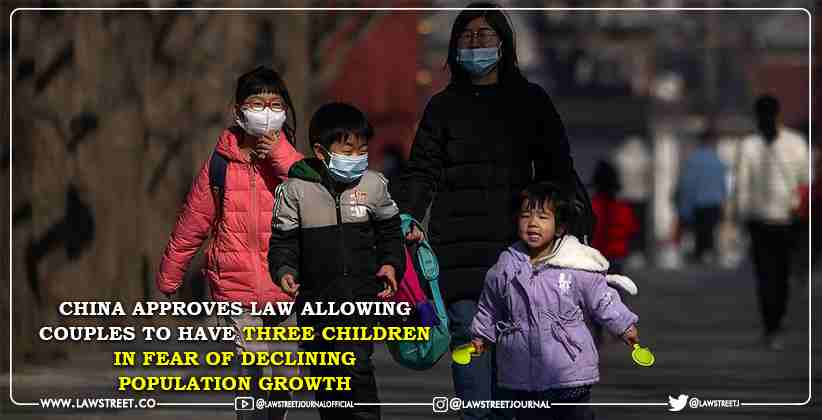In what could be a major policy shift, China has formally revised its laws to allow couples to have three children in a bid to aid the country's declining birth rate. The move (recommended by the Communist Party) was formalized by the National Legislation on Friday (August 20, 2021).
The revised Population and Family Planning Law approved by the Standing Committee of the National People's Congress (NPC) states that the country will roll out new measures to aid the change and address the reluctance of families to have more children due to added costs. This will include supportive measures in finances, insurance, education, housing, and employment to elevate the burden of the couples as also the cost of raising children.
According to a local daily report, the law was revised to 'implement the central leadership's decision to cope with new circumstances in social and economic development and promote balanced long-term population growth.'
Background:
Decades ago, China had in place the draconian one-child policy, which was passed in view of the demographic crisis of the country at the time. As per officials, the said policy, which was implemented three decades ago, successfully prevented over 400 million births.
In 2016, the country scrapped the policy and allowed couples to have two children. The policy is now amended to permit and, in fact, encourage families to have three children in order to boost the country's declining population growth.
Current Changes:
The decision to permit the third child has come in after a census showed China's population grew at the slowest pace of 1.412 billion. Official projections further revealed that the decline in the birth rate might begin as early as next year.
The figures also revealed that the population of people above 60 years old had grown to 264 million or up to 18.7 percent last year. Commenting on it, Ning Jizhe, head of the National Bureau of Statistics (NBS), said, "Data shows the aging of the Chinese population has further deepened, and we will continue to face the pressure to achieve a long-term balanced population development."
Statistical Analysis:
China is said to be facing the issue of low fertility as it recorded only 12 million births in 2020, marking a drop for the fourth year in a row. It was stated that the fertility rate of women of childbearing age was as low as 1.3.
On the other hand, a 2019 UN report stated that India had an estimated population of 1.37 billion and China 1.43 billion, and by 2027, India's population is projected to surpass China's. India is expected to add nearly 273 million people between now and 2050 and will remain the most populated country through the end of the current century, the report noted.
What Experts Have to Say:
As per Dan Wang, Chief Economist at Hang Seng Bank (China), the three-child policy could have a positive impact on China's birth rate but not as much as is expected. "The high costs of housing and education, as well as a lack of job protection for women, are strong economic constraints on having children," she said while noting that most middle-class families will not be able to afford the costs of a third child.
Another report by China's central bank - the People's Bank of China (PBOC), noted that the country's demographics are set to change as its population growth will enter the negative after 2025, resulting in a shortage of consumer demand. Remarking on it, Cai Fang, a member of the monetary policy committee of the PBOC, said, "When the total population enters negative growth [after 2025], there will be a shortage of demand. We need to pay attention to the impact of demographics on future consumption."
The PBOC also recommended that China should liberalize birth policies and not interfere with people's ability to have children, or it could run the risk of an irreversible economic impact of a declining population.
In addition to the new law and the supportive changes, China will also look at a more progressive and flexible route towards raising the retirement age.











